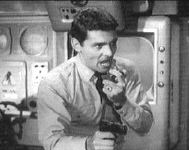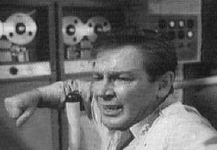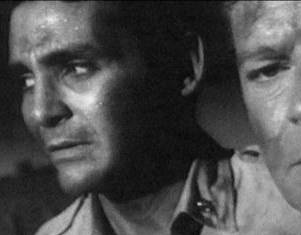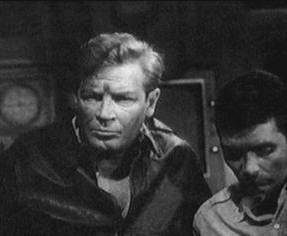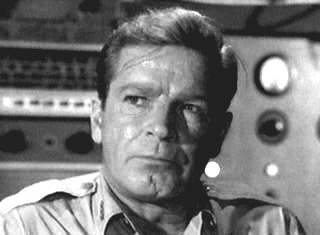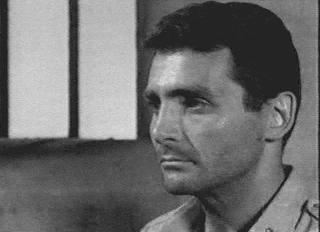The Dark Side of
Voyage to the Bottom of the
Sea
Raw nerves and blind fear .
. . "Mutiny"
Season One boiled with darkly confrontational themes . .
.
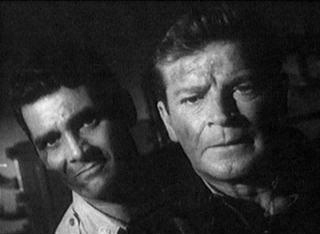 |
|
|
First year shows were often tight, tense and gritty, as in
"Submarine Sunk
Here." | | |
|
Anyone familiar with
Voyage
's first
season is well aware that many episodes
stormed with darkly confrontational undercurrents. Science fictional or not, there was a
gritty realism in the scripts that the black-&-white format suited to
a "t". Whether driven by an experimental fear-inducing gas (The
Fear Makers), bigotry (The Price of Doom), an overdose
of medication (Mutiny), a political monster (The
Exile), or just the pressure of diving where no unprotected
human could live for even seconds (The Condemned ), Season One's plots often
explored the darker side of the human condition. Voyage
did this
not only with style, but also with high production values,
and consistently good, occasionally excellent, writing. No fan of the series need be ashamed
of Season One's
shows. | |
| Suspicion played a key role
in the early shows. Suspicion of the unknown, and its darkest
form, suspicion of one another. Who was a spy? Who was an
enemy? | |
|
| Suspicion's close cousin, fear,
was dealt with regularly. The show's real focus was not on fear
per se, but rather, on how the crew, men of solid virtue,
dealt with
it. | |
|
The ultimate horror: Nelson realizes
it's no game--he's been ordered to launch offensive nuclear weapons
in "Doomsday," a cautionary tale.
| |
|
Season One
Voyage
dealt with issues as well. Nelson,
a scientist, is also an admiral with an
admiral's responsibilities. In the episode "Doomsday," he
confronts missile control officer Corbett about his failure to activate
Failsafe when so ordered:
Corbett: "This is doomsday,
Admiral--doomsday!"
Nelson: "If it is, we didn't start
it."
Corbett:
"What
difference is it who started it? It's one thing to carry a big
stick--it's another to bash someone's head in with it. I just
couldn't do it. But you
could!" (he
looks astonished) "Couldn't you, Admiral?"
Nelson: "You
think that because I do what I have to do I don't feel . .
. " Nelson chokes, but recovers. "Our job is to
provide the bone and muscle of our country's deterrent power.
If we fail in that . . . if we freeze in the clutch, our country's
defenseless. You failed your country once before--don't ever
fail her again. " This said, you know Nelson damn well
means it in spite of the implicit horror.
| |
William Read Woodfield's powerful cautionary script
for "Doomsday" poses a horrible dilemma for both Nelson and Crane.
They are duty-bound to carry out their orders in spite of the fact
that to do so is madness. The writer is clearly on the side of
Corbett, who pleads the case for humanity, arguing that there is a line
past which individuals are not bound by orders. And at the
conclusion of the drama, the viewer sides with Corbett in spite of
the fact that his military career is ruined and Nelson is obviously the
show's daddy/hero. Fairly bold stuff to air in 1964 during the cold
war and a brewing Vietnam, "Doomsday" is arguably
Voyage
's finest attempt to deal with social and moral issues.
"The Sky is Falling" and "The Price of Doom" also take a firm stand,
although in the context of science
fiction.
|
|
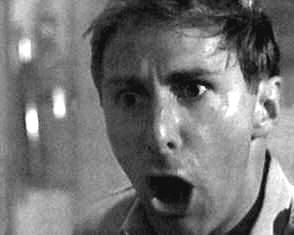
In
Doomsday, pleading the case for humanity.
Donald
Harron as Corbett--a standout performance.
|
|
Prison bars and a five o'clock shadow. In
the Captain's book, there could be no concession to brute
force. | |
As noted, not only was Season
One often dark, it could be gritty as well. Such is the case
with the episode, Mist of Silence
, the title of which literally refers to a wall
of poisonous nerve gas that first, puts Crane and several Seaview
crew (including Kowalski) in the clutches of a decidedly evil South
American would-be dictator. Beyond that, the title also refers to
the cancerous pall that blind subservience to any aspiring military
bully or dictator must inevitably lead.
In this episode, a
frightened, screaming Seaview crew member is dragged away and shot
in cold blood. Crane narrowly escapes the same fate.
This kind of brutal realism was exorcized from Voyage
when it went to color and was moved
to the 7:00 Sunday-night family slot opposite Disney in the fall of
1965. | |
As always, thanks to Stephanie Kellerman
for help with photos.
 Back to
Classic Episodes
Central
Back to
Classic Episodes
Central
 Back to
Main Page
Back to
Main Page
| "Voyage to the Bottom of the Sea" ® is a registered
trademark of Irwin Allen Properties, LLC. © Irwin Allen
Properties, LLC and Twentieth Century Fox Film Corporation. All
rights
reserved. | |
